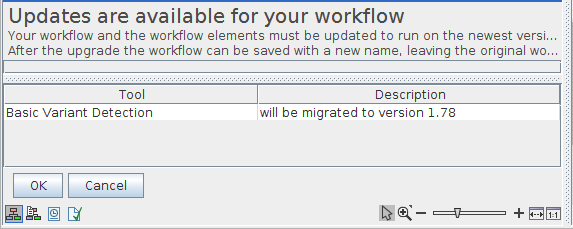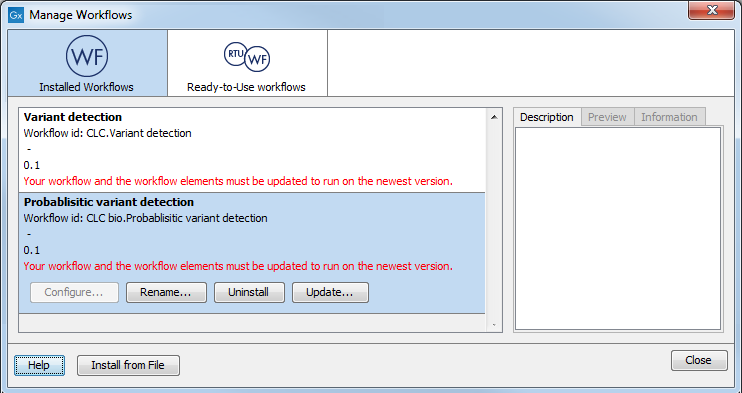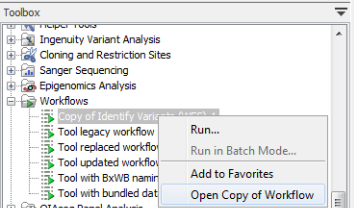Workflow version and update
A workflow has a version. The version is used to make it easy to distribute an improved version of the same workflow. To do this, create a new installer with an incremented version number. In order to install a new and updated version, the old one has to be uninstalled.
If a workflow needs to be updated, it must be updated before it can be used. Please note that:
- When you update a workflow, the older version is overwritten.
- If new parameters have been added to a tool as part of the update, these parameters will be set to their default values within the updated workflow.
Updating workflows in the Navigation area
If a workflow stored in a CLC Data Location needs to be updated, this will become apparent when it is opened from the Navigation Area of the Workbench. In this case, an editor appears that lists the tools that need to be updated (figure 9.47). The workflow must be updated before it will be opened in the Workflow editor, and edited or launched. Click on the OK button at the bottom of the editor to update the workflow.

Figure 9.47: When updates are available, an editor appears with information about which tools should be updated. Press "OK" to update the workflow.
Updating installed workflows within the same major release line
|
"Major release line" refers to the first digit in the version number. For example: CLC Genomics Workbench 10.0.1 and 10.5 are releases within the same major release line. The major release number here is 10. CLC Genomics Workbench 9.x is is part of a different major release line than 10.x because the major version number is different (9 versus 10). |
You can update installed workflows within the same major release line using the Workflow Manager tool.
Open the "Manage Workflows..." tool by selecting it after clicking on the "Workflows" button in the top toolbar of the Workbench (see figure 9.48) Select the workflow that needs to be updated. Workflows you installed directly will be under the "Custom Workflows" tab. Click on the "Update" button.

Figure 9.48: A message is shown indicating that a workflow needs to be updated. Clicking on that workflow selects it, and a button labeled "Update" will be visible.
To update a workflow you must have permission to write to the area the workflow is stored in. For workflows you installed directly, you will normally be able to do this when running the Workbench as you usually do. To update workflows distributed via plugins, it will usually mean running the Workbench as an administrative user.
Updating installed workflows between major release lines
To update a workflow between major release lines, a Workbench version the installed workflow can be run on is needed, as well as the latest version of the Workbench.
To start, open a copy of the installed workflow in a version of the Workbench it can currently be run on. This is done by selecting the workflow in the Installed Workflows folder of the Toolbox in the bottom left side of the Workbench, then right-clicking on the workflow name and choosing the option "Open Copy of Workflow" (figure 9.49).

Figure 9.49: Open a copy of an installed workflow by right-clicking on its name in the Workbench Toolbox.
Save the copy of the workflow in the Navigation Area. To do this, you can simply drag and drop the tab to the location of your choice in the Navigation Area.
Open the new version of the Workbench and there, open the workflow that was saved in the Navigation Area. Click on the OK button if you are prompted to update the workflow.
You can now check that the workflow has been updated correctly, including that any reference data is configured as expected. Then save the updated version of the workflow. Finally, click the Installation button to install the worfklow, if desired.
If the above process does not work when upgrading directly from a much older Workbench version, it may be necessary to upgrade step-wise by upgrading the workflow in sequentially higher major versions of the Workbench.
